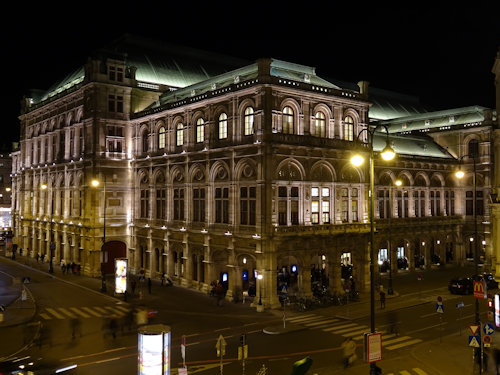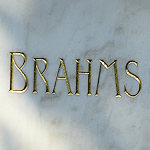
Hamburg-born Johannes Brahms (1833-1897) spent some time in Vienna in the early 1860s before moving here permanently a few years later.
Like Mozart and Beethoven before him, this extraordinary composer soon found himself adopted by Austria’s capital as one of its own.
- Book a concert experience* in Vienna
- See also:
Unlike Beethoven, Brahms didn’t change addresses as often as his underwear; he had rooms at a house on Karlsgasse throughout the final 25 years of his stay in Vienna.
That house is no more, but a plaque at least marks the site. The following map highlights this and other locations connected intimately to Brahms’ life in the city, with photos, explanations, and links below.
Jump to Brahms locations related to his…
Brahms: his life
We begin with a look at three wall-mounted plaques that highlight notable locations associated with Brahms’ residences and friends, though the original buildings are all no more, sadly.
Homes and haunts
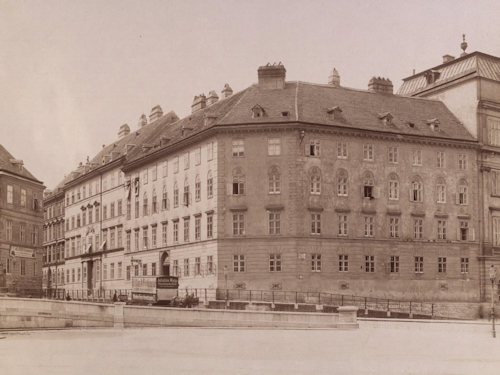
(Karlsgasse 2-4 / Karlsplatz 12, the house where Johannes Brahms lived and died; photo taken around 1904 by August Stauda; Wien Museum Inv.-Nr. 29432; excerpt reproduced with permission under the terms of the CC0 licence)
One is, of course, at the aforementioned Karlsgasse 2-10, the site of Brahms’ long-time (and final) residence. The plaque says (my translation):
On this location stood the house that Johannes Brahms lived in from January 1st, 1872 and where he died on April 3rd, 1897
The current building is one end of the Technical University of Vienna and full of seminar rooms. Here’s what the plaque looks like:

(The Karlsgasse plaque)
The same university has another classical music connection: Vivaldi’s grave lies underneath it (the wall at Karlsplatz 13 facing the Karlskirche church has a commemorative plaque).
Another plaque is at Linke Bahngasse 1A and notes (my translation):
The house “Zum Goldspinnerin” once stood on this site. The composer Johannes Brahms lived here from 1869 to 1871.
Based on the further inscription, the plaque was put up on April 3rd, 1997, on the occasion of the 100th anniversary of Brahms’ death:
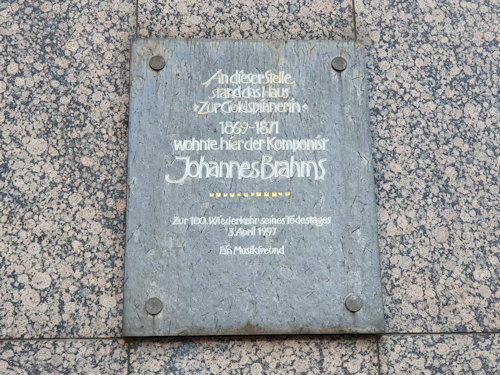
(An anonymous “friend of music” is responsible for the commemorative tablet on Linke Bahngasse)
The third plaque is inside the entranceway of the housing complex at Landstraßer Hauptstraße 96. This says (again, my translation):
Johannes Brahms spent many hours in the company of the Fellinger family in this house from 1893 until his death. Many of his works were heard here for the very first time.
A second inscription notes that the first plaque used to hang on the side of Palais Arenberg, which stood at this location until its demolishment in the 1950s.
Deutschordenshaus
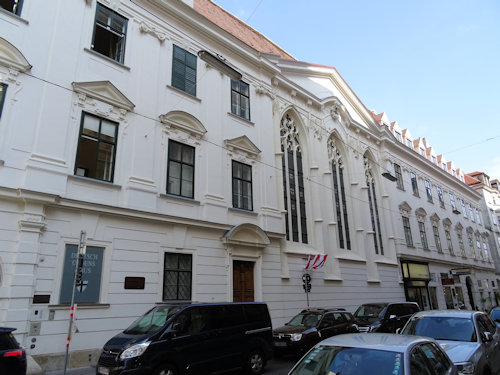
(Also a former residence of Mozart)
One former abode of Brahms that still survives is the Deutschordenshaus, home to the Teutonic order in Vienna. He lived there for a while during his first long stay in the city in the 1860s.
But this is Vienna, so Brahms’ presence barely warrants a mention for that particular location. Why? Because it has an even greater claim to musical fame.
A few decades earlier (1781), Mozart slept there on a visit to the city with his employer, the Archbishop of Salzburg. The two argued, Mozart was kicked out, and the rest is, as they say, history.
Stadtkirche and grave
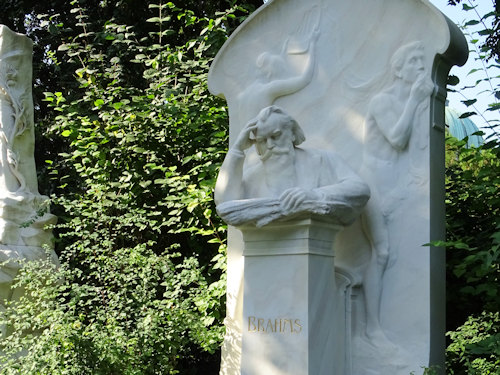
(The headstone)
Brahms died on April 3rd, 1897 at his home on Karlsgasse.
The funeral service took place three days later at the Lutherische Stadtkirche church in the very centre of Vienna (at Dorotheergasse 18). This evangelical church traces its roots back to a late 16th century convent church built by Elisabeth of Austria, a former queen of France.
(The coffin’s journey to the Stadtkirche included a stop at the Musikverein concert venue for the laying of a wreath.)
After the service, they buried Brahms in Section 32A of Vienna’s Zentralfriedhof cemetery. His grave lies between two friends of his: fellow composer Johann Strauss (the son) and Nikolaus Dumba (a noted patron of the arts in 19th-century Vienna).
The graves of Schubert and Beethoven are just a couple of piano lengths away.
Brahms: his music
The Musikverein
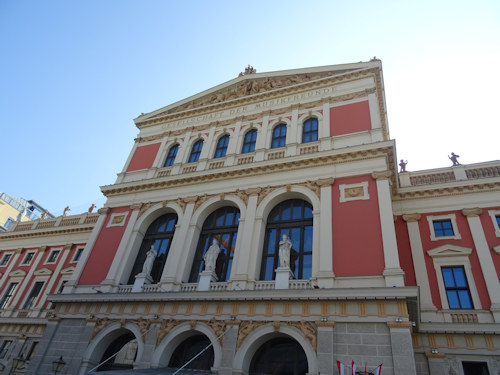
(The front façade)
The grand and famous Musikverein building enjoys many associations with famous composers and musicians of the past and present. But Brahms has a particularly close connection to this concert venue. For example, he served as its artistic director for three years from 1872.
The pavement outside the front entrance (just to the right as you face it) has a star for Brahms with his signature, alongside other such musical greats as Schoenberg.

(The Brahms pavement star)
The second-largest concert hall inside carries Brahms’ name and has a bust of the composer on display. The best way to see this Brahms-Saal is through a concert or the Musikverein tour.
The building also played host to premieres of some of Brahms’ better-known works, including his second and third symphonies and Variations on a Theme by Haydn.
Staatsoper
(The Staatsoper state opera house)
On November 2nd and 3rd, 1879, the State Opera House (them the Hofoper) put on a concert by the Wiener Philharmoniker orchestra featuring works by Johannes Brahms, Felix Mendelssohn-Bartholdy, and Ludwig van Beethoven. Brahms himself conducted.
Redoutensaal
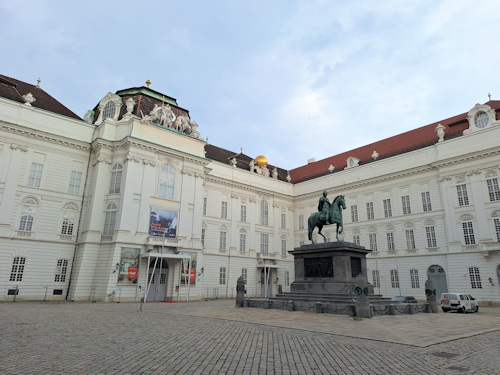
(The Redoutensaal rooms are in the building on the right of this picture of Josefsplatz square)
Brahms cantata for tenor solo, male chorus and orchestra – Rinaldo – premiered inside the Hofburg palace complex in 1869. The location was the large Redoutensaal, now part of a conference centre. But you can, at least, see the outside by standing on Josefsplatz.
Brahms also conducted the Wiener Philharmoniker and choirs there on occasion.
Brahms: memorials & more
The Haydnhaus

(The museum includes a Brahms room)
Another composer closely associated with Vienna is Joseph Haydn (1732-1809), and his final residence is now the Haydnhaus museum.
You might ask what that has to do with Brahms, given Johannes only entered this world some years after Haydn’s death.
In the absence of a surviving Brahms apartment in Vienna, one room within the Haydnhaus has been turned over to the man who himself was a great admirer of Haydn’s works.
Inside this “Brahms room” you’ll find a timeline, furniture and other items, including paintings of his piano room and desk. Brahms once owned Haydn’s clavichord, which you can also see in the museum.
Brahms statue

(The statue looks across to his old workplace)
The city of Vienna erected a monument to Brahms in 1908 on what would have been his 75th birthday. You’ll find it just outside Karlsplatz subway station in the park opposite the Wien Museum and close to the Musikverein.
The marble and granite installation has the elderly and bearded composer seated on the top. Euterpe, one of the nine muses and the one most closely associated with music, lies on the wider plinth below with her lyre.
Haus der Musik

(The museum has a Brahms-themed display cabinet)
The Haus der Musik museum has a set of rooms dedicated to those composers closely associated with Vienna. Exhibits inside what is the city’s main museum of sound and music include an ink pen and a pair of reading glasses that once belonged to Brahms
Historical Music Collection
The historical musical instrument collection at the Neue Burg in the town centre has numerous keyboard instruments that once felt the authoritative touch of a master musician. One such exhibit is a grand piano used by Brahms.
Brahmsplatz

(You’re not a proper composer until Vienna has a street sign with your name)
And finally…Vienna also commemorates Brahms through a square in the 4th district named after him. Brahmsplatz consists of a small park surrounded by rather fine examples of turn-of-the-century architecture.
